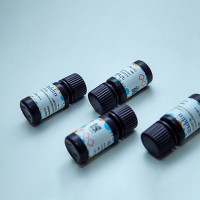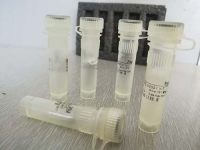Analysis of RNA by Northern and Slot‐Blot Hybridization
互联网
- Abstract
- Table of Contents
- Materials
- Figures
- Literature Cited
Abstract
Specific sequences in RNA preparations can be detected by blotting and hybridization analysis using techniques very similar to those originally developed for DNA. Fractionated RNA is transferred from an agarose gel to a membrane support (northern blotting), while unfractionated RNA is immobilized by slot or dot blotting. The resulting blots are studied by hybridization analysis with labeled DNA or RNA probes. Included in this unit are detailed procedures for RNA denaturation, blotting and hybridization. Also described is a method for stripped hybridization probes from blots so the blots can be re?hybridized with a different probe.
Table of Contents
- Basic Protocol 1: Northern Hybridization of RNA Fractionated by Agarose‐Formaldehyde Gel Electrophoresis
- Alternate Protocol 1: Northern Hybridization of RNA Denatured by Glyoxal/DMSO Treatment
- Alternate Protocol 2: Northern Hybridization of Unfractionated RNA Immobilized by Slot Blotting
- Support Protocol 1: Removal of Probes from Northern Blots
- Reagents and Solutions
- Commentary
- Literature Cited
- Figures
- Tables
Materials
Basic Protocol 1: Northern Hybridization of RNA Fractionated by Agarose‐Formaldehyde Gel Electrophoresis
Materials
Alternate Protocol 1: Northern Hybridization of RNA Denatured by Glyoxal/DMSO Treatment
Alternate Protocol 2: Northern Hybridization of Unfractionated RNA Immobilized by Slot Blotting
Support Protocol 1: Removal of Probes from Northern Blots
Materials
|
Figures
-

Figure 5.17.1 Rat liver RNA (5 µg) was electrophoresed on a formaldehyde 1% agarose gel containing ethidium bromide (left), transferred to a hybridization membrane and stained with methylene blue stain (Molecular Research Center; Herrin and Schmidt, , right). Shown are 28S (4.7 kb) and 18S (1.9 kb) ribosomal RNAs, as well as 4S to 5S (0.10 to 0.15 kb) RNA containing mix of tRNA and 5S ribosomal RNA. View Image
Videos
Literature Cited
| Literature Cited | |
| Alwine, J.C., Kemp, D.J., and Stark, G.R. 1977. Method for detection of specific RNAs in agarose gels by transfer to diazobenzyloxymethyl‐paper and hybridization with DNA probes. Proc. Natl. Acad. Sci. U.S.A. 74:5350‐5354. | |
| Bailey, J.M. and Davidson, N. 1976. Methylmercury as a reversible denaturing agent for agarose gel electrophoresis. Anal. Biochem. 70:75‐85. | |
| Bodkin, D.K. and Knudson, D.L. 1985. Assessment of sequence relatedness of double‐stranded RNA genes by RNA‐RNA blot hybridization. J. Virol. Methods 10:45‐52. | |
| Brown, T.A. (ed.) 1991. Molecular Biology Labfax. BIOS Scientific Publishers, Oxford. | |
| Casey, J. and Davidson, N. 1977. Rates of formation and thermal stabilities of RNA:DNA and DNA:DNA duplexes at high concentrations of formamide. Nucl. Acids Res. 4:1539‐1552. | |
| Chomczynski, P. 1992. One‐hour downward alkaline capillary transfer for blotting of DNA and RNA. Anal. Biochem. 201:134‐139. | |
| Herrin, D.L. and Schmidt, G.W. 1988. Rapid, reversible staining of Northern blots prior to hybridization. BioTechniques 6:196‐200. | |
| Kafatos, F.C., Jones, C.W., and Efstratiadis, A. 1979. Determination of nucleic acid sequence homologies and relative concentrations by a dot hybridization procedure. Nucl. Acids Res. 7:1541‐1552. | |
| Lehrach, H., Diamond, D., Wozney, J.M., and Boedtker, H. 1977. RNA molecular weight determinations by gel electrophoresis under denaturing conditions: A critical reexamination. Biochemistry 16:4743‐4751. | |
| Peferoen, M., Huybrechts, R., and De Loof, A. 1982. Vacuum‐blotting: A new simple and efficient transfer of proteins from sodium dodecyl sulfate–polyacrylamide gels to nitrocellulose. FEBS Lett. 145:369‐372. | |
| Smith, M.R., Devine, C.S., Cohn, S.M., and Lieberman, M.W. 1984. Quantitative electrophoretic transfer of DNA from polyacrylamide or agarose gels to nitrocellulose. Anal. Biochem. 137:120‐124. | |
| Southern, E.M. 1975. Detection of specific sequences among DNA fragments separated by gel electrophoresis. J. Mol. Biol. 98:503‐517. | |
| Thomas, P.S. 1980. Hybridization of denatured RNA and small DNA fragments transferred to nitrocellulose. Proc. Natl. Acad.Sci. U.S.A. 77:5201‐5205. | |
| Wilkinson, M. 2000. Purification of RNA. In Essential Molecular Biology:A Practical Approach 2nd edition., Vol. 1 (T.A. Brown, ed.) pp. 69‐88. Oxford University Press, Oxford. |







